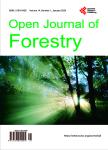Family Forest Owners’ Motivation to Control Understory Vegetation: Implications for Consulting Forestry
Family Forest Owners’ Motivation to Control Understory Vegetation: Implications for Consulting Forestry作者机构:School of Agricultural Forest and Environmental Sciences Clemson University Clemson USA
出 版 物:《Open Journal of Forestry》 (林学期刊(英文))
年 卷 期:2013年第3卷第4期
页 面:99-103页
学科分类:1002[医学-临床医学] 100214[医学-肿瘤学] 10[医学]
主 题:Forest Vegetation Management Chemical Control Family Forest Owners Consulting Forestry
摘 要:Forest vegetation management has evolved as a recognized component of intensive forest management practice. It involves the management of competing vegetation necessary to obtain the high yields expected in modern forest plantations via control of interfering plants that influence regeneration outcome, impact timber stand development, and limit native plant and wildlife diversity. It includes cultural control, fire control, mechanical control, biological control, and chemical control. The public perception of forest vegetation management, especially chemical control, is sometimes negative due to health and environmental concerns. It is an important tool in the forest management alternatives available to consulting foresters managing family forest lands (the vast majority of private forest land in the United States). We report on a study that addresses the motivations of family forest owners that implement forest vegetation management practices and the motivation of those who chose not to implement after forester recommendations to do so. For those who do implement forest vegetation management, improvement of wildlife habitat and increased timber growth was the main motivation. For those who did not, cost was the main concern. Size of forest holding plays a major role in determining who will practice intensive forestry.



